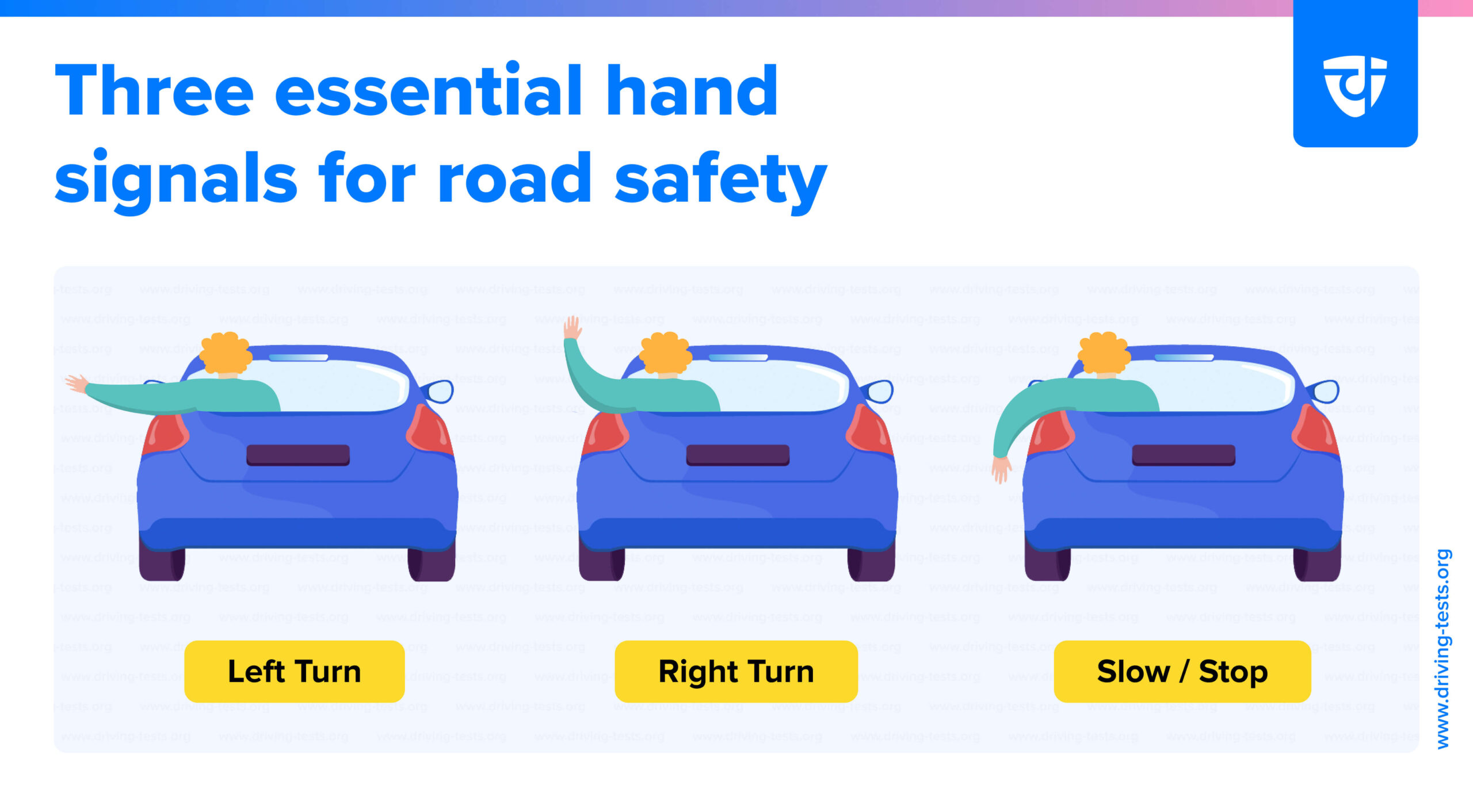Hand Signals for Driving: 3 Essential Gestures You Should Know
Understanding hand signals driving techniques is essential, especially when your car’s lights fail. This guide provides detailed instructions on using hand signals, supported by traffic laws and practical scenarios.

Left Turn

To signal a left turn, extend your left arm straight out from the driver’s side window, keeping your arm parallel to the ground and your fingers pointed or your palm facing forward. This signal is universally recognized and should be used well in advance of the turn, allowing other drivers and cyclists to adjust their speed or position accordingly.
Right Turn

Signaling a right turn involves extending your left arm out of the window and bending it upwards at a 90-degree angle with your palm facing forward. This position mimics the direction of a right turn and is crucial for alerting drivers behind and beside you of your intention to change lanes or turn right, especially in situations where your vehicle’s turn signals are not functioning or visible.
Slow Down or Stop

To indicate that you are stopping or slowing down, extend your left arm out of the window and angle it downwards, bending at the elbow with your palm facing behind you. This signal is particularly important in emergencies or sudden traffic halts, providing a clear indication to trailing vehicles that they need to reduce speed or prepare to stop.
Usage Tips
- Visibility: Always ensure your hand signals are clear and visible to other drivers and pedestrians. Use these signals in good lighting conditions and consider wearing reflective gloves if signaling at dusk or dawn.
- Timeliness: Signal well in advance of your action to give others sufficient time to react safely.
- Supplementary Use: Remember, hand signals are meant to supplement your vehicle’s turn signals, not replace them entirely. They are especially useful if your vehicle’s signals are malfunctioning or when driving older vehicles without turn signal lights.
- Practice: Regularly practice hand signals driving in a safe environment to build muscle memory and confidence in using these gestures when needed.
Historical and Legal Context
Hand signals for driving have a long history, dating back to the early days of motoring before the advent of electronic signals. Legally, they’ve been incorporated into traffic laws globally to ensure safety when modern signaling systems fail.
Real-Life Scenarios
Effective hand signaling is not only a skill for driving tests but a real-life necessity in various scenarios. Understanding these can prevent accidents and ensure clear communication on the road.
Here are some scenarios where hand signals are vital:
-
Emergency Brake Failure: Imagine you’re driving and suddenly your brake lights stop working. In such an emergency, the stop hand signal can alert drivers behind you that you’re slowing down, potentially preventing a rear-end collision.
-
Classic Car Rallies: In events featuring classic cars, many of which may not have modern signaling systems, using hand signals is a common practice. This ensures safety and clear communication among participants.
-
Motorcycle Group Rides: During group motorcycle rides, riders often use hand signals to communicate with each other, especially for turns and stops, as engine braking in motorcycles doesn’t activate brake lights.
-
Bicycle Commuting in Urban Areas: Cyclists use hand signals to indicate turns and stops, crucial in busy urban traffic where visibility and clear communication can prevent accidents with vehicles and pedestrians.
-
Driving in Foreign Countries: When driving abroad, you may encounter vehicles using hand signals due to different traffic regulations or older vehicle models. Recognizing these signals can help in understanding the intentions of other drivers, ensuring safer driving in unfamiliar environments.
-
When Towing: If you’re towing a trailer or caravan and the lights aren’t functioning properly, hand signals can be a temporary solution to communicate with other drivers on the road, especially during lane changes or turns.
Knowing these hand signals and understanding their importance across different scenarios and regions enhances road safety for everyone.
Key Takeaways
- Essential for Emergencies: Hand signals are vital when your vehicle’s lights fail.
- Universal Language: Hand signals driving is a universal language that helps communicate intentions clearly across different types of vehicles and road users.
- Legal Mandate: In many regions, using hand signals is a legal requirement. See Road Rules for legal aspects.
- Three Key Signals: Learn signals for left turn, right turn, and slowing down/stopping.
- Visibility and Safety: Enhance signal visibility with reflective gloves in low-light.
- Diverse Applications: Crucial for cars with lighting issues, motorcycles, and bicycles.
- Historical Significance: Hand signals have been legally integrated globally for safety.
Their Importance
Hand signals driving techniques are essential in road safety, acting as a universal language that bridges gaps between drivers worldwide. They are crucial for enhancing communication on the road, especially when verbal communication isn’t possible and vehicle signals are inadequate or malfunctioning.
Enhancing Communication and Safety:
- Hand signals allow drivers to communicate intentions like turning, changing lanes, or stopping, reducing the risk of collisions and improving traffic flow.
- They are vital when a vehicle’s turn signals are not visible due to sunlight or fail due to technical issues.
Legal Requirements and Best Practices:
- In many places, hand signals are not just recommended; they’re legally required if vehicle signaling devices are out of order.
- They’re also a key component of driving tests, highlighting their importance in driver education.
Universal Recognition:
- Despite minor variations, the basic hand signals for left turn, right turn, and stopping are universally recognized.
- This makes them an effective communication tool for drivers internationally.
Supporting Non-Verbal Cues:
- Hand signals are an indispensable tool in non-verbal communication among drivers, offering a clear way to convey driving intentions without verbal or eye contact.
Hand signals remain a simple yet effective tool in enhancing road safety, preventing accidents, and ensuring mutual understanding among road users, despite advancements in vehicle technology.
When to Use Hand Signals
Hand signals aren’t always the go-to; modern vehicles are pretty good at communicating for us. But, there are a few instances where they become your best friends on the road:
- Lighting Issues: When those blinkers or brake lights bow out, hand signals are your stopgap solution. Especially if you can’t fix the lights pronto. Remember, signal at least 100 feet before you turn – it’s not just courteous, it’s often the law.
- Emergency Situations: When faced with unexpected electrical failures, knowing hand signals driving methods can be crucial for maintaining safe communication on the road.
- Motorcycle Moments: In the world of motorcycles, especially in group rides or when your signal lights are on the fritz, hand signals keep the pack safe. Plus, engine braking doesn’t trigger the brake light, so your hand needs to do the talking.
- Bicycle Bound: No built-in signals on your bicycle? No problem. Hand signals are crucial for sharing the road safely with other vehicles.
Whether in a car, on a motorcycle, or pedaling a bicycle, hand signals are your silent allies in safe driving. They’re not just about passing your test or dodging tickets; they’re about making sure everyone on the road gets where they’re going without a hitch. So, give those hand signals a wave – they could be more powerful than you think!
Citations
- National Highway Traffic Safety Administration. (2024). Hand Signals. U.S. Department of Transportation. Retrieved from https://www.nhtsa.gov/sites/nhtsa.gov/files/8009-handsignals.pdf
- California Department of Motor Vehicles. (2024). California Driver Handbook. Retrieved from https://www.dmv.ca.gov/portal/driver-handbooks/
- Virginia Department of Motor Vehicles. (2024). Virginia Driver’s Manual. Retrieved from https://www.dmv.virginia.gov/sites/default/files/forms/dmv39.pdf

